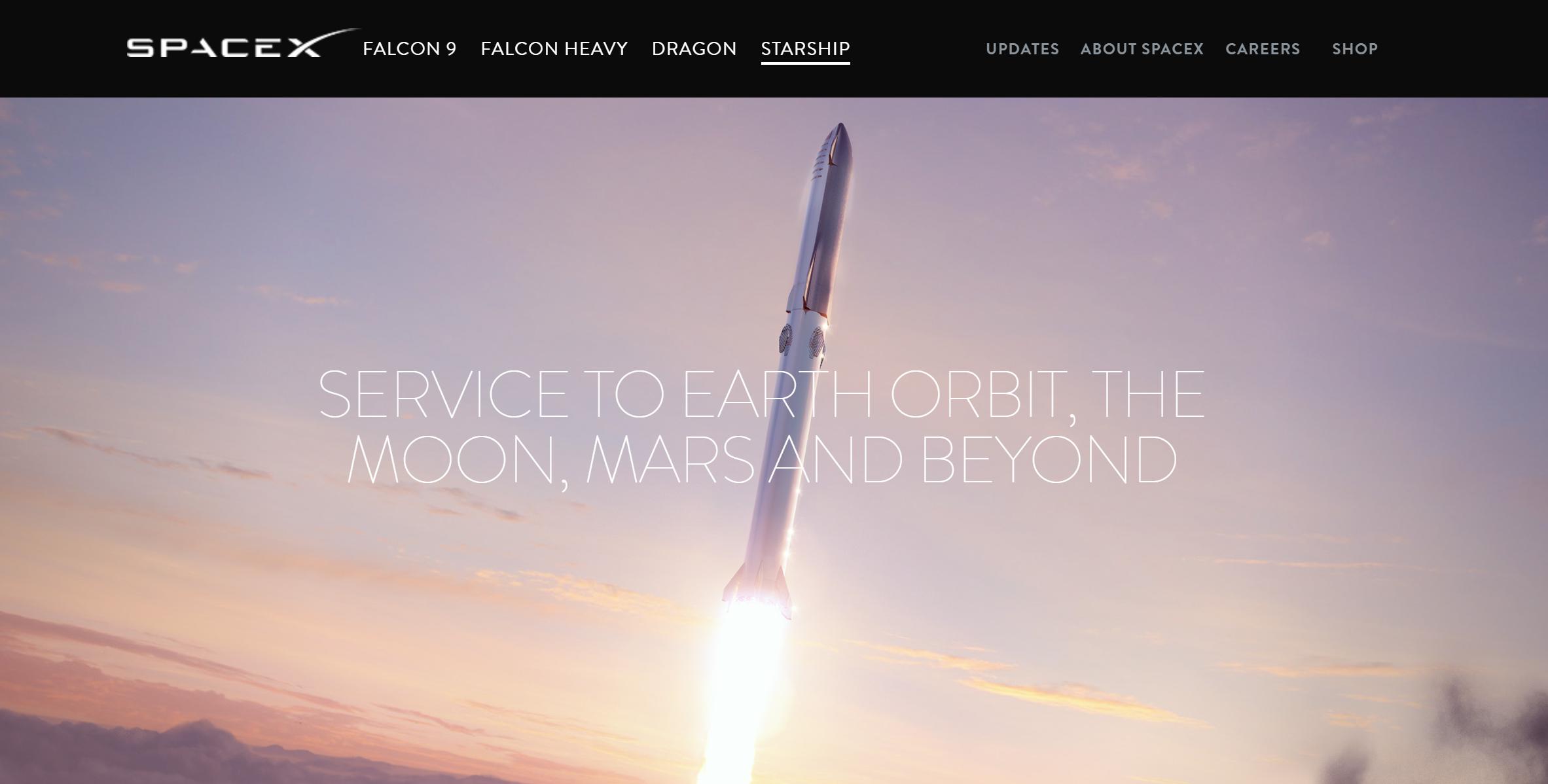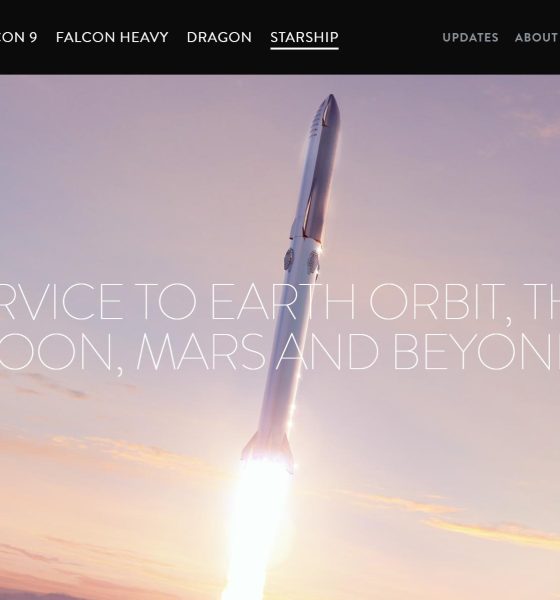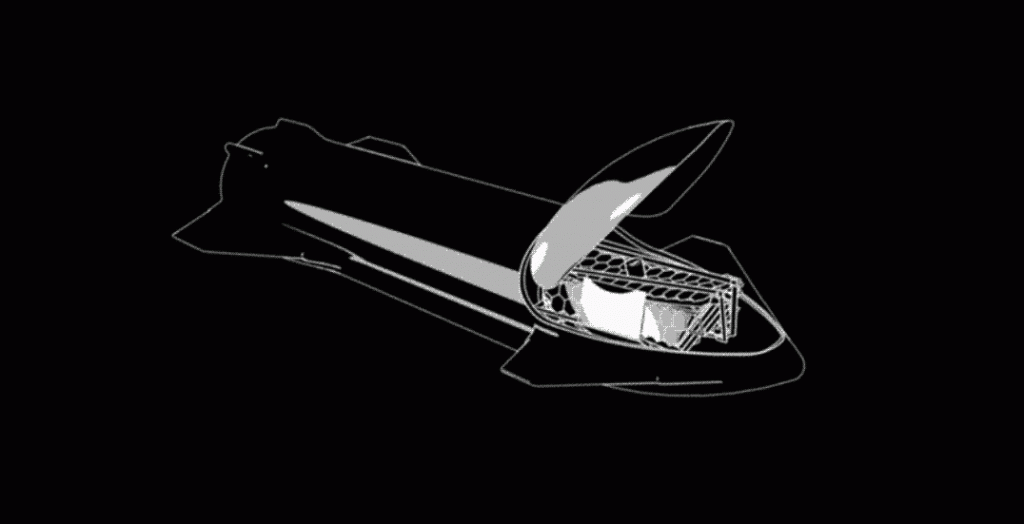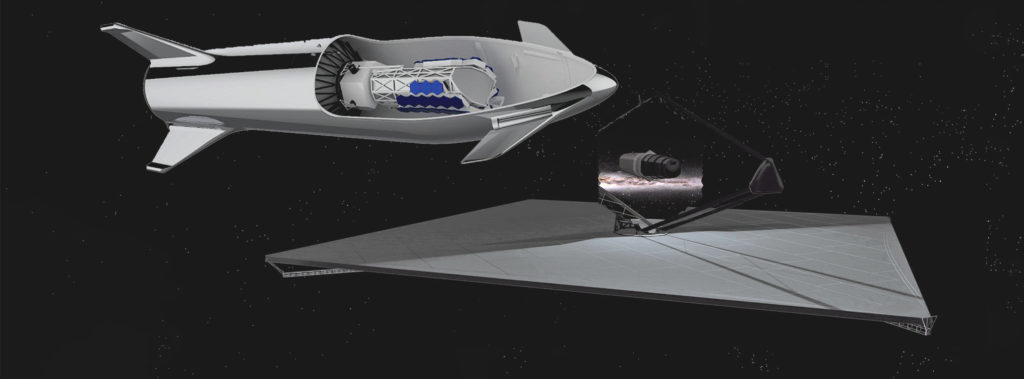

News
SpaceX publishes dedicated Starship webpage after Elon Musk’s presentation
Shortly after CEO Elon Musk’s 2019 presentation, SpaceX has published a new webpage dedicated to the next-generation Starship launch vehicle and its Super Heavy booster, detailing the rocket and providing some excellent new images and renders.
Beyond the images of Raptor and renders of Starship and Super Heavy, the webpage discusses several possible use-cases in Earth orbit and throughout the solar system, showing off the latest iteration of a cargo-focused Starship and teasing possible missions to the Space Station.
Known informally as “Chomper” in the spaceflight community, a cargo-optimized Starship would replace the pressurized crew section with a vast cargo bay and actuating door, the source of its nickname. Similar to but slightly simpler than the Space Shuttle’s famous clamshell doors, such a nose could be extremely useful. Although it could obviously be used to place massive payloads in orbit, a sealable cargo section could also be used to grab similarly large items on orbit and then either return them to Earth or service/repair them in situ.

Of note, NASA’s Goddard Space Flight Center (GSFC) – responsible for the proposed LUVOIR super-telescope – has already seriously begun considering a cargo-optimized Starship as one of a handful of possible launch options. In the event that LUVOIR is chosen for development by NASA, the massive space telescope could be ready for launch sometime in the 2030s, at which point GSFC believes there will be only three plausible options – NASA’s SLS, Blue Origin’s New Glenn, or SpaceX’s Starship.

According to LUVOIR’s extensively detailed “Final Report”, published less than a month ago, GSFC worked fairly closely with SpaceX to determine where exactly Starship might fit into the picture. Intriguingly, an April 2019 tweet from the Center revealed that SpaceX had verified that Starship would be able to launch LUVOIR-B, a smaller and simpler version of the telescope. The August 2019 report, however, reveals that Starship could also launch LUVOIR-A – the full-sized telescope – with just a few slight modifications to Starship’s payload section.

SpaceX acknowledged Starship’s already well-known potential for transporting cargo and crew to the Moon and Mars, but also noted that the massive spacecraft could be used to deliver cargo and crew to the International Space Station (ISS) or elsewhere in Earth orbit. The ISS is undeniably large but Starship is (relatively) even bigger, nominally featuring enough pressurized volume (~1000m3 vs ~910m3) to more than double the habitable capacity of the ISS upon arrival. CEO Elon Musk noted this in an offhand remark on September 28th, cognizant of the fact that a Starship on its own is effectively a reusable ISS-class space station that can be placed in orbit with a single launch.
If a given Starship can support a crew of astronauts over a multi-month interplanetary cruise, the same Starship can also – and probably even more easily so – serve as an all-in-one space station with months of longevity. Add in Starship-enabled resupply and refueling runs and SpaceX could likely sustain a fleet of autonomous space stations in Earth orbit with relative ease. Assuming SpaceX is interested, Starship launch prices are low enough, and a large enough market exists, Starship could almost instantly and singlehandedly take orbital tourism from a distant fantasy for billionaires to a serious market potentially accessible to hundreds of thousands or even millions of people.
Musk has noted in previous SpaceX presentations that the goal is to make Starship so reusable that the price of per-person tickets to Mars becomes comparable to buying a house ($500k to $1m). Assuming SpaceX gets close to that price target, the cost of a 100-person mission low Earth orbit – likely requiring just one launch – could potentially be comparable to buying a car (~$50,000).
Check out Teslarati’s Marketplace! We offer Tesla accessories, including for the Tesla Cybertruck and Tesla Model 3.

Elon Musk
Delaware Supreme Court reinstates Elon Musk’s 2018 Tesla CEO pay package
The unanimous decision criticized the prior total rescission as “improper and inequitable,” arguing that it left Musk uncompensated for six years of transformative leadership at Tesla.

The Delaware Supreme Court has overturned a lower court ruling, reinstating Elon Musk’s 2018 compensation package originally valued at $56 billion but now worth approximately $139 billion due to Tesla’s soaring stock price.
The unanimous decision criticized the prior total rescission as “improper and inequitable,” arguing that it left Musk uncompensated for six years of transformative leadership at Tesla. Musk quickly celebrated the outcome on X, stating that he felt “vindicated.” He also shared his gratitude to TSLA shareholders.
Delaware Supreme Court makes a decision
In a 49-page ruling Friday, the Delaware Supreme Court reversed Chancellor Kathaleen McCormick’s 2024 decision that voided the 2018 package over alleged board conflicts and inadequate shareholder disclosures. The high court acknowledged varying views on liability but agreed rescission was excessive, stating it “leaves Musk uncompensated for his time and efforts over a period of six years.”
The 2018 plan granted Musk options on about 304 million shares upon hitting aggressive milestones, all of which were achieved ahead of time. Shareholders overwhelmingly approved it initially in 2018 and ratified it once again in 2024 after the Delaware lower court struck it down. The case against Musk’s 2018 pay package was filed by plaintiff Richard Tornetta, who held just nine shares when the compensation plan was approved.
A hard-fought victory
As noted in a Reuters report, Tesla’s win avoids a potential $26 billion earnings hit from replacing the award at current prices. Tesla, now Texas-incorporated, had hedged with interim plans, including a November 2025 shareholder-approved package potentially worth $878 billion tied to Robotaxi and Optimus goals and other extremely aggressive operational milestones.
The saga surrounding Elon Musk’s 2018 pay package ultimately damaged Delaware’s corporate appeal, prompting a number of high-profile firms, such as Dropbox, Roblox, Trade Desk, and Coinbase, to follow Tesla’s exodus out of the state. What added more fuel to the issue was the fact that Tornetta’s legal team, following the lower court’s 2024 decision, demanded a fee request of more than $5.1 billion worth of TSLA stock, which was equal to an hourly rate of over $200,000.
Delaware Supreme Court Elon Musk 2018 Pay Package by Simon Alvarez
News
Tesla Cybercab tests are going on overdrive with production-ready units
Tesla is ramping its real-world tests of the Cybercab, with multiple sightings of the vehicle being reported across social media this week.

Tesla is ramping its real-world tests of the Cybercab, with multiple sightings of the autonomous two-seater being reported across social media this week. Based on videos of the vehicle that have been shared online, it appears that Cybercab tests are underway across multiple states.
Recent Cybercab sightings
Reports of Cybercab tests have ramped this week, with a vehicle that looked like a production-ready prototype being spotted at Apple’s Visitor Center in California. The vehicle in this sighting was interesting as it was equipped with a steering wheel. The vehicle also featured some changes to the design of its brake lights.
The Cybercab was also filmed testing at the Fremont factory’s test track, which also seemed to involve a vehicle that looked production-ready. This also seemed to be the case for a Cybercab that was spotted in Austin, Texas, which happened to be undergoing real-world tests. Overall, these sightings suggest that Cybercab testing is fully underway, and the vehicle is really moving towards production.
Production design all but finalized?
Recently, a near-production-ready Cybercab was showcased at Tesla’s Santana Row showroom in San Jose. The vehicle was equipped with frameless windows, dual windshield wipers, powered butterfly door struts, an extended front splitter, an updated lightbar, new wheel covers, and a license plate bracket. Interior updates include redesigned dash/door panels, refined seats with center cupholders, updated carpet, and what appeared to be improved legroom.
There seems to be a pretty good chance that the Cybercab’s design has been all but finalized, at least considering Elon Musk’s comments at the 2025 Annual Shareholder Meeting. During the event, Musk confirmed that the vehicle will enter production around April 2026, and its production targets will be quite ambitious.
News
Tesla gets a win in Sweden as union withdraws potentially “illegal” blockade
As per recent reports, the Vision union’s planned anti-Tesla action might have been illegal.

Swedish union Vision has withdrawn its sympathy blockade against Tesla’s planned service center and showroom in Kalmar. As per recent reports, the Vision union’s planned anti-Tesla action might have been illegal.
Vision’s decision to pull the blockade
Vision announced the blockade in early December, stating that it was targeting the administrative handling of Tesla’s facility permits in Kalmar municipality. The sympathy measure was expected to start Monday, but was formally withdrawn via documents sent to the Mediation Institute and Kalmar Municipality last week.
As noted in a Daggers Arbete report, plans for the strike were ultimately pulled after employer group SKR highlighted potential illegality under the Public Employment Act. Vision stressed its continued backing for the Swedish labor model, though Deputy negotiation manager Oskar Pettersson explained that the Vision union and IF Metall made the decision to cancel the planned strike together.
“We will not continue to challenge the regulations,” Petterson said. “The objection was of a technical nature. We made the assessment together with IF Metall that we were not in a position to challenge the legal assessment of whether we could take this particular action against Tesla. Therefore, we chose to revoke the notice itself.”
The SKR’s warning
Petterson also stated that SKR’s technical objection to the Vision union’s planned anti-Tesla strike framed the protest as an unauthorized act. “It was a legal assessment of the situation. Both for us and for IF Metall, it is important to be clear that we stand for the Swedish model. But we should not continue to challenge the regulations and risk getting judgments that lead nowhere in the application of the regulations,” he said.
Vision ultimately canceled its planned blockade against Tesla on December 9. With Vision’s withdrawal, few obstacles remain for Tesla’s long-planned Kalmar site. A foreign electrical firm completed work this fall, and Tesla’s Careers page currently lists a full-time service manager position based there, signaling an imminent opening.








